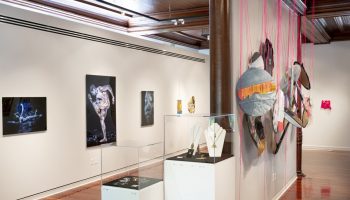Sangram Majumdar talks about paintings like C.S. Lewis wrote about wardrobes – as if whole worlds are waiting within them.
“That world continues, beyond the frame of the painting,” Majumdar said. “You can go into it. You can travel in there.”
He’s interested in how a painting functions like a room, in that the viewer can be drawn into the painting and imagine its universe as extending past the borders of the frame. Like a photograph, the image in the painting is only a monocular moment in a larger scene.
In his lecture at 7 p.m. Tuesday in the Hultquist Center, Majumdar will reflect on his process and how his work has changed over time, as well as share some of his influences and inspirations.
Over the years, he’s been interested in the work of various artists: Richard Diebenkorn, John Singer Sargent, Alice Neel, Henri Matisse and Marsden Hartley, for example. Some of these influences held longer than others — Majumdar gave up on Sargent, was ambivalent about Hartley and ended up revisiting many times.
“Matisse led me to a whole different group of artists,” he said. “Certain artists are gateway artists.”

Majumdar keeps the history and tradition of painting in mind when creating his own works. He’s fascinated by that past, but wary of producing copycat content.
“I believe in what the medium can do, but I’m also not interested in being part of a fan club,” he said.
He doesn’t want to paint in a way that looks “back to the good old days over and over again,” but in some ways he considers himself like a scavenger, “somebody who goes around and collects things from odd places,” in that he tries to combine various idioms of painting — like landscape, still-life and portrait — into something new.
Majumdar’s primary works are large, vibrant oil paintings, but he also works in gouache, acrylic, pastel, charcoal and graphite during his “editing process.” While creating a large painting, Majumdar makes collages and works on paper to better visualize what he’s trying to achieve. He isn’t sure that his smaller works should be called “studies,” as they’re not just prep work and he doesn’t have a one-to-one ratio of study to painting, but changing mediums and seeing the painting in a compact format can be helpful.
“Other times it’s about allowing myself permission to make drastic changes that feel maybe a little scary to do on a big scale,” he said. “When you’re invested in something for a longer period of time, there’s an anxiety about change. Sometimes it becomes a bit unnerving, so the drawings or the smaller works become a way to maybe trick myself into this space of freedom.”
Majumdar is familiar with the anxiety of change. Some of his earlier works dealt with the stress caused by frequent travel, as well as recognizing the possibilities presented by unknown places.
“As you’re transitioning from one place to another, there is this hope of something new happening,” he said.
Majumdar, who was born in India, has traveled extensively throughout the United States, as well as to Spain, France, Italy and Singapore.
“A big part of my life, really, until I moved to New York, has been about travel,” he said.
Majumdar commutes from New York to teach painting and drawing at the Maryland Institute College of Art in Baltimore.
“The idea of being away, but then coming back to this space that you know, is very important to me,” he said.
Over time, his paintings have become more abstract, but he’s still interested in spaces and rooms.
“More and more the work is about keeping the viewer in a state of simultaneity,” he said. “It is prolonging that state of unknowing, or that state of possibility, and trying to make that state visually charged, in a way that you want to be there, you want to go in.”




